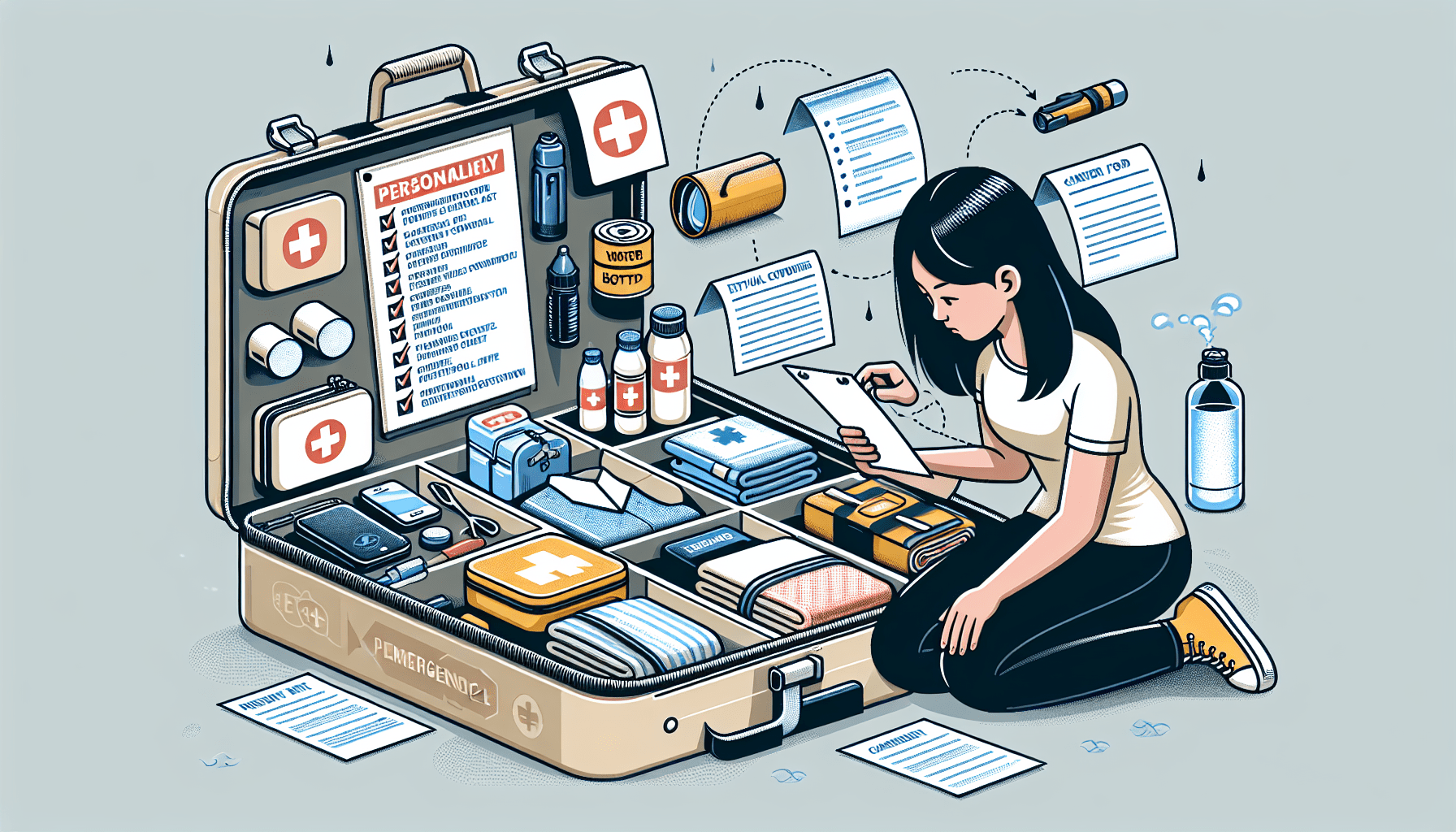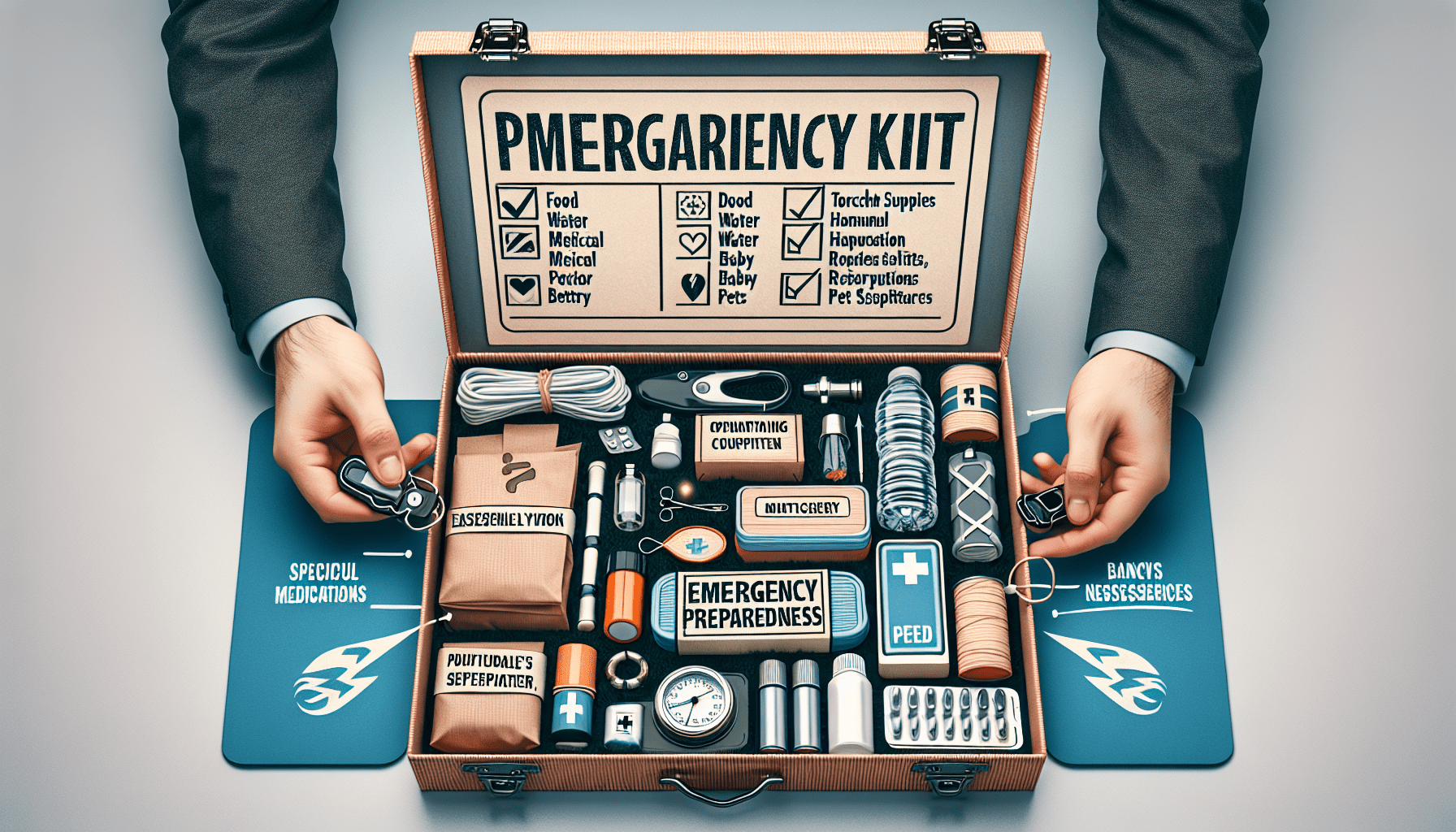Imagine a world where you feel completely prepared for any unexpected emergencies that may come your way. Picture yourself confidently navigating through a crisis, knowing that you have everything you need to keep yourself and your loved ones safe and secure. In this article, we will explore the importance of customizing your emergency preparedness kit to suit your specific needs, ensuring that you have all the essential items for any situation. From first aid supplies to food and water provisions, we will guide you through the process of creating a comprehensive emergency kit that gives you peace of mind and the ability to face any challenge that comes your way.

Assessing Your Needs
When it comes to preparing for emergencies, it’s crucial to assess your specific needs. Not everyone’s situation is the same, so it’s important to identify potential emergencies, consider your location, and assess your personal circumstances.
Identifying potential emergencies
Start by considering the potential emergencies that are most likely to occur in your area. Are you prone to severe storms, flooding, or earthquakes? Or maybe you live in an area with a higher risk of wildfires. By identifying these potential emergencies, you can better prepare for the specific challenges they may present.
Considering your location
Your location plays a significant role in determining your preparedness needs. If you live in a rural area, you may need to consider additional supplies and resources compared to someone living in an urban environment. Access to clean water, healthcare facilities, and emergency services can vary depending on where you live, so take these factors into account when customizing your emergency preparedness kit.
Assessing your personal circumstances
Consider your personal circumstances when preparing your emergency kit. Do you have any family members with special needs, such as infants, elderly adults, or pets? If so, make sure to include any necessary supplies or medications they may require. Additionally, take into account any specific medical conditions or dietary restrictions that you or your family members have to ensure you have what you need in case of an emergency.
Basic Essentials
There are several fundamental items that should be included in any emergency preparedness kit. These essentials will help ensure your basic needs are met during a crisis.
Water and purification methods
Water is perhaps the most crucial item to include in your emergency kit. Aim to have a minimum of one gallon of water per person per day for at least three days. It’s also important to have a means of purifying water, such as water purification tablets or a portable water filter, in case your supply becomes contaminated.
Non-perishable food
In addition to water, non-perishable food items are essential to sustain you and your family during an emergency. Stock up on canned goods, dry foods (like rice and pasta), and high-energy snacks. Make sure to regularly rotate these items to maintain their freshness.
First aid kit
A well-stocked first aid kit is vital in an emergency. Include bandages, adhesive tape, antiseptic solutions, pain relievers, and any necessary prescription medications. Don’t forget to check and replenish your first aid supplies periodically.
Flashlights
Having a reliable light source is crucial during power outages or when navigating dark areas. Invest in quality flashlights and store extra batteries. Consider including headlamps for hands-free illumination.
Batteries
Stock up on a variety of batteries for all your electronic devices and other battery-operated items in your emergency kit. Having extra batteries on hand will ensure that you can power your communication devices and other essential items as needed.
Climate-Specific Items
Depending on the climate in which you live, there are additional items you may need to include in your emergency kit.
Extra warm clothing and blankets
If you live in an area with colder climates, it’s essential to have extra warm clothing and blankets in your emergency kit. Thermal blankets, extra layers, and sturdy winter gear will help keep you warm during power outages or if you need to evacuate to a cold environment.
Sunscreen and hats for hot climates
For those living in hot and sunny climates, protecting yourself from the sun’s harmful rays is crucial. Include sunscreen with a high SPF and wide-brimmed hats to shield yourself from excessive sun exposure during emergencies.
Rain gear for wet climates
If your region is prone to rainy weather or hurricanes, make sure to pack rain gear, such as waterproof jackets, pants, and boots, in your emergency kit. Staying dry is essential for preventing hypothermia and maintaining overall comfort during wet weather situations.

Communication Tools
Having the means to communicate during an emergency is vital for obtaining necessary information and staying connected with loved ones.
Battery-powered or hand-crank radio
A battery-powered or hand-crank radio is an essential item to include in your emergency kit. This will allow you to stay informed about local weather updates, emergency broadcasts, and important announcements if power and internet access are unavailable.
Cell phone with portable charger
Your cell phone can be a lifeline during emergencies, so make sure to include it in your kit. Additionally, pack a portable charger or a backup battery to ensure you can keep your phone powered even if electricity is unavailable.
Emergency contact list
Create a list of important emergency contacts, including family members, friends, neighbors, and local emergency services. Include both phone numbers and email addresses. Keep a printed copy in your emergency kit, as well as a digital copy saved on your phone or other devices.
Personal Hygiene
Maintaining good personal hygiene during an emergency is crucial for preventing illness and maintaining overall well-being.
Toilet paper
Include an ample supply of toilet paper in your emergency kit. This basic necessity often goes overlooked, but having an adequate stock can significantly improve comfort during challenging times.
Hand sanitizer
When access to soap and water is limited, hand sanitizer becomes invaluable. It helps kill germs and reduces the risk of infections. Pack travel-sized hand sanitizers in your emergency kit for on-the-go cleanliness.
Soap
In addition to hand sanitizer, include bars or bottles of soap in your kit. Liquid soap can be used for handwashing and general cleaning purposes. Having clean hands is essential for preventing the spread of diseases.
Feminine hygiene products
For individuals who menstruate, it’s crucial to include an adequate supply of feminine hygiene products in your emergency kit. Choose products that are comfortable, portable, and suitable for your preferences.
Prescription Medications
If you or any family member relies on prescription medications, it’s vital to include an ample supply in your emergency kit.
A week’s supply of prescription medications
Ensure you have at least a week’s supply of prescription medications in your emergency kit. Ask your healthcare provider about obtaining extra medication, if possible, to have on hand for emergencies.
Over-the-counter medications
Include a selection of over-the-counter medications, such as pain relievers, fever reducers, antihistamines, and any necessary medications for specific conditions (e.g., asthma inhalers). Check expiration dates regularly and replace them as needed.
Medical equipment if necessary
If you or a family member relies on medical equipment, such as a nebulizer or oxygen concentrator, make sure to have extra supplies and batteries readily available in your emergency kit. Consult with your healthcare provider for specific recommendations based on individual needs.
Important Documents
Having essential documents readily accessible during emergencies can help facilitate a smoother recovery process.
Copies of identification documents
Make copies of important identification documents, such as passports, driver’s licenses, and birth certificates. Keep these copies in a waterproof container within your emergency kit.
Insurance policies
Include copies of your insurance policies, including health, home, and automobile insurance. These documents will be helpful if you need to file a claim after an emergency.
Medical records
If possible, include copies of important medical records, such as allergies, vaccination records, and recent test results. Storing these records digitally or in paper format can assist healthcare providers if medical attention is needed during or after an emergency.
Emergency contact information
Compile a list of emergency contact numbers, including family members, friends, neighbors, doctors, and insurance providers. Keep this list in your emergency kit for easy access.
Tools and Supplies
In addition to the basic essentials, there are several tools and supplies that can prove invaluable during emergencies.
Multi-tool
A multi-tool is a versatile item that combines various tools in one compact device. It can include features such as knives, pliers, screwdrivers, and wrenches. Having a multi-tool in your emergency kit ensures you have a wide range of tools at your disposal.
Duct tape
Duct tape is a versatile adhesive that can serve numerous purposes in emergency situations. It can be used for various repairs, sealing openings, or creating makeshift solutions. Including a roll of duct tape in your kit can prove incredibly useful.
Whistle
A whistle is a simple yet effective tool for attracting attention during emergencies. In situations where verbal communication might be difficult or impossible, a whistle can help alert others to your presence.
Rope
Include a length of sturdy rope in your emergency kit. Rope can be used for multiple purposes, such as securing items, constructing makeshift shelters, or providing support during rescue situations.
N95 masks
N95 masks offer respiratory protection from harmful particles and can be particularly useful during emergencies that involve poor air quality, such as wildfires or environmental disasters. Keep a supply of N95 masks in your emergency kit.
Entertainment and Comfort
While it’s essential to focus on survival and safety during emergencies, it’s also important to consider the comfort and mental well-being of you and your loved ones.
Books or magazines
Including a few books or magazines in your emergency kit can provide a much-needed distraction and entertainment during stressful times. Choose materials that are uplifting or enjoyable to read.
Playing cards or board games
Playing cards or compact board games can help pass the time and provide entertainment when power and internet access are unavailable. Include a deck of cards or a small, portable board game in your kit.
Favorite comfort items
Everyone has different comfort items that can provide a sense of familiarity and security during emergencies. Whether it’s a stuffed toy, a favorite pillow, or a special blanket, include these items in your emergency kit to help reduce anxiety and promote emotional well-being.
Special Considerations
Depending on your specific circumstances, there may be additional items to include in your emergency kit.
Pet supplies
If you have pets, make sure to include necessary supplies for their well-being. This may include food, water, medications, leashes, carriers, and vaccination records. Consider their specific needs and pack accordingly.
Baby or infant necessities
If you have infants or young children, pack essential items such as formula, diapers, wipes, bottles, and extra clothing in your emergency kit. Additionally, include any specific items that provide comfort to your child, such as a favorite stuffed animal or blanket.
Special needs items
If you or a family member has special needs, ensure you have the necessary supplies and equipment readily available in your emergency kit. This may include items such as wheelchair batteries, hearing aids, communication devices, or specialized medications. Consult with healthcare providers or specialists to tailor your kit to specific requirements.
By customizing your emergency preparedness kit to meet your unique needs, you can ensure that you and your loved ones are better equipped to handle unforeseen situations. Remember to regularly review and update your kit, replace expired items, and communicate your emergency plans with family members and neighbors. Stay prepared, stay safe!
